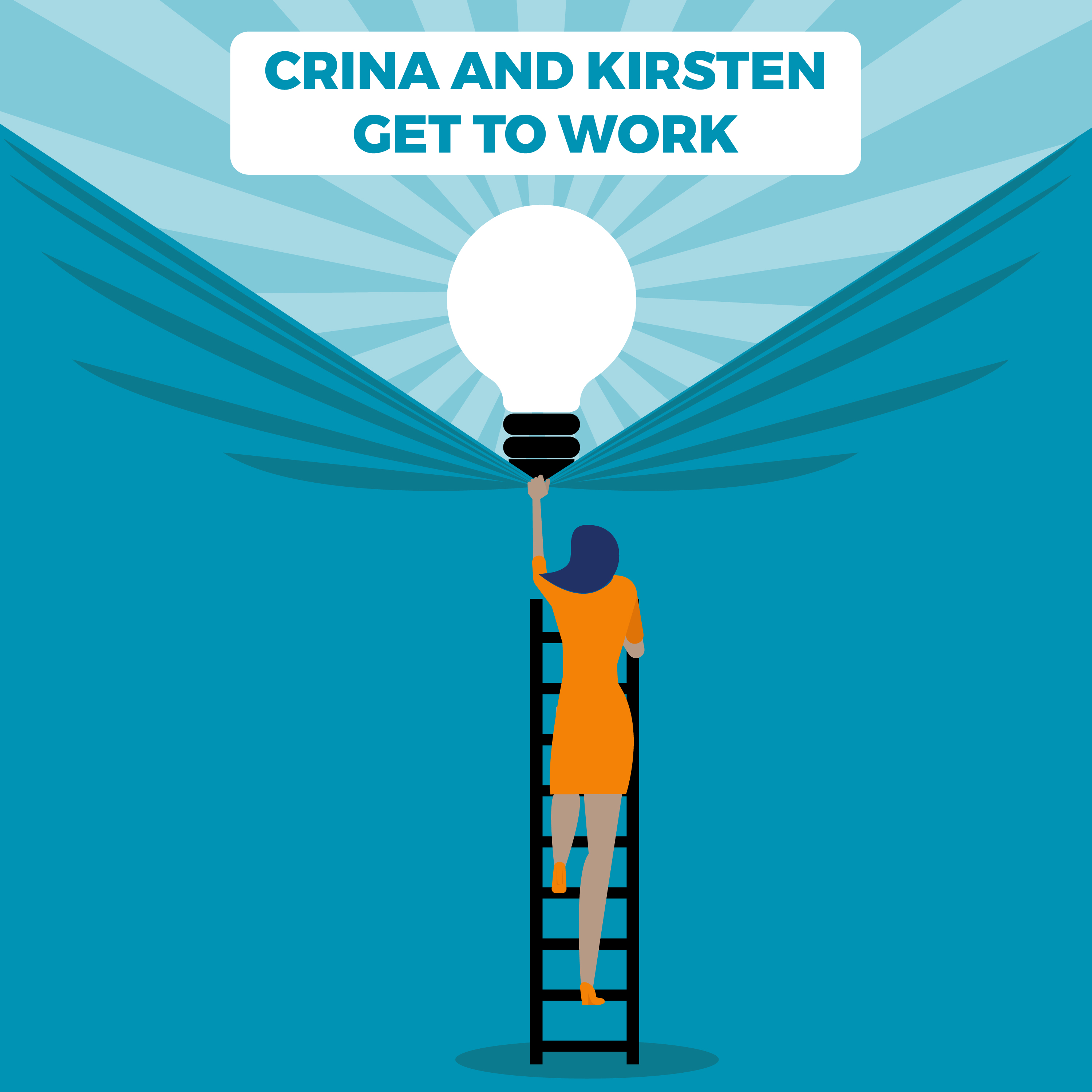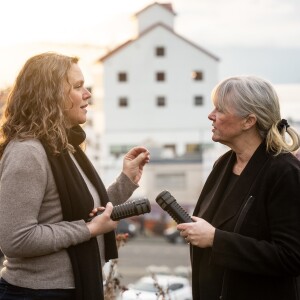Crina and Kirsten Get to Work

We have one single mission: Help women find ease, meaning and joy at work and in life. We use our experiences as business owners, entrepreneurs, mentors and inspirational leaders to explore topics that all working women care about: shitty bosses; smashing the patriarchy; balancing work and life; navigating change and getting what you want! We guarantee that you will be entertained and inspired... promise!
Episodes
Episodes



Friday Jun 27, 2025
Assertive Communication - Clear, Confident and Calm
Friday Jun 27, 2025
Friday Jun 27, 2025
It’s time to focus on the often-misunderstood art of assertiveness—what it is, what it isn’t, and how learning to speak up for yourself with clarity and respect, which can change your life! Whether it’s Crina telling it like it is or just learning to speak up with friends, this episode illustrates just how transformative assertiveness can be, especially for those of us who’ve spent years saying “yes” when we really meant “no.”
Drawing on guidance from the Mayo Clinic, the episode breaks down assertiveness as a healthy, balanced communication style—firm but respectful, confident without being combative. It’s a powerful antidote to stress, resentment, and burnout, especially if you tend to overextend yourself in an effort to keep the peace. Unlike aggression, which bulldozes others, or passivity, which erases your own needs, assertiveness helps you communicate clearly while still honoring relationships and boundaries.
Listeners are reminded that assertiveness isn’t about being the loudest voice in the room—it’s about knowing what you need, expressing it directly, and listening to others with the same respect you expect in return. It’s a skill, not a personality trait, and it can be learned and practiced. The episode offers practical tools: use “I” statements to own your feelings, practice saying no without apology, and pay attention to your body language—standing tall, making eye contact, giving yourself some time to respond and staying calm in moments of tension. And any of us who struggle with this may want to start small.
You’ll also learn how to identify the traps of passive or passive-aggressive behavior—like saying yes when you mean no, or expressing frustration through sarcasm—and how these patterns can damage relationships and leave you feeling powerless. With time and effort, assertiveness can lead to greater self-confidence, healthier connections, and more honest communication both at work and in your personal life.
The takeaway? Assertiveness isn’t just about getting what you want—it’s about being clear about who you are. Whether you’re dealing with a pushy colleague, a longtime friend, or a well-meaning but overbearing father-in-law, learning to assert yourself with clarity, confidence and calm is one of the most powerful tools we can develop.
Good Read:
Being assertive: Reduce stress, communicate better - Mayo Clinic



Friday Jun 13, 2025
The Power of Being Seen at Work: Mattering Matters
Friday Jun 13, 2025
Friday Jun 13, 2025
“Mattering,” is one of the most underrated superpowers in the workplace!. Not "I got a cupcake on my work anniversary" mattering—but the real, gut-level kind where you feel seen, valued, and essential. Turns out, this isn't fluff. According to Crina, It's fuel.
Now, let’s clear something up: mattering isn’t the same as belonging. Belonging says, “You’re one of us.” Mattering says, “You’re essential to us.” It’s not just about being invited to the meeting—it’s knowing your presence changes what happens in the room.
We explore how leaders can make mattering happen through one simple (but wildly uncommon) practice: noticing. It’s seeing your team for more than their output. It’s remembering that Ava’s prepping for a big client meeting or that Margaret is quietly holding the team together. As an example, it is the lovely leader who wrote down one meaningful detail about each employee every Friday and followed up on Mondays. No grand gestures—just consistent, personal attention. Her team was consistently the most engaged in the building.
And it’s not just about seeing—it’s about hearing. We go beyond the nod-and-smile version of active listening to something deeper. It’s listening for total meaning—what people say, how they say it, what they don’t say, and what they’re feeling underneath. It’s following up. It’s asking, “What did you mean by that?” or “How did that feel?” or “Tell me more” and being ready to actually hear the answer.
We also talk about how to affirm people without sounding like a motivational poster. True affirmation is personal and specific. It’s not “you’re amazing”—it’s “your attention to detail really added to the quality of our work product.” When people feel their unique strengths are noticed, they show up stronger, take feedback better, and stay longer.
Ease. Meaning. Joy. They’re not nice-to-haves. They’re what happens when people know they matter. Let’s get after creating some mattering!
More to read:
The Power of Mattering at Work



Friday May 30, 2025
The Paper Ceiling - Another One to Shatter
Friday May 30, 2025
Friday May 30, 2025
There’s a persistent and punishing myth out there: that a college degree is the only ticket to a good life. Spoiler alert—it’s not. And the people hit hardest by this myth? Women without degrees, especially women of color, who are holding up families, caregiving, and entire communities while being boxed out of opportunity by arbitrary job requirements and social stigma.
Four out of five non-graduates say they’ve experienced some form of judgment for not having a degree. Education-based stigma and discrimination among young adults not in 4-year college | BMC Psychology. Many employers still cling to degree requirements as if they are a magic wand for competence. Meanwhile, a generation of students is waking up to the fact that college isn’t the only (or even the best) path. In 2023, there were four million fewer college students than a decade ago. Interesting.
But for non-college women, the journey without packing a college degree is anything but scenic. The economic reality is significant. Half of working-age non-college women aren’t working full-time. Their median annual income is just $35,000—30% less than non-college men. And while non-college men still find decent-paying jobs in fields like manufacturing or construction, the landscape for women is shrinking fast. Their sectors—think retail, caregiving, service—are unstable, underpaid, and rarely lead to careers. Third Way.
And yet, these women are the backbone of millions of households. Nearly four million homes with children rely solely on the income of a woman without a college degree. And while certificates and credentials could help, they don’t offer women the same financial bump they give men. A woman earns just a 16% wage premium from a certificate; men get 27%.
So why do degree requirements still rule? Employers think they signal capability. But studies are questioning the ROI of four-year degrees, and forward-thinking companies (and states!) are finally ditching the B.A. bias. More than 20 states have scrapped degree mandates for government jobs, and Congress is cooking up bipartisan plans to fund non-traditional learning paths through the Stronger Workforce for America Act and the Workforce Pell Act.
The takeaway? The “paper ceiling” is cracking. But breaking it wide open means recognizing that skill, drive, and talent don’t come with a diploma. It’s time we rewrite the rules—and the résumés—to build a workforce that actually works for everyone.
Another good read:
Americans can get behind dropping degree requirements—but employers and hiring managers keep propping up the 'paper ceiling' | Fortune



Friday May 16, 2025
The Journey to Authentic Leadership: Your Story Matters
Friday May 16, 2025
Friday May 16, 2025
Trust in leadership is eroding, with only about one in five employees reporting confidence in their leaders (Gallup, 2023). What’s going wrong—and more importantly, what does it take to lead in a way that earns trust? The answer to this question is simply bringing our authentic selves to our leadership.
Research on authentic leadership shows that effective leaders don’t follow a specific checklist of traits or styles. Instead, leadership grows from a much deeper place: our life stories. Drawing from interviews with over 100 leaders and thousands of pages of transcripts, researchers found that great leadership is shaped through real-world challenges, self-reflection, and a willingness to lead from our values. Discovering Your Authentic Leadership
Authentic leaders aren’t simply “being themselves”—they’re doing the ongoing work of knowing themselves. That includes:
-Reflecting on life experiences, including adversity, to understand what drives them-Practicing their values, especially when it’s hard or costly-Balancing extrinsic rewards (recognition, promotions) with intrinsic purpose (meaning, impact)-Building strong support teams that offer perspective, truth, and unconditional encouragement
This research challenges the idea that leadership is about image, status, or "executive presence." Instead, proposes effective leadership grounded in honesty, clarity, and the courage to lead with integrity—even when it is uncomfortable or comes at a price.
Our life experiences are what can create a platform for strong leadership - everything from working with some not-so-great bosses to how parents, losses, and major setbacks can unexpectedly shape our leadership style.
Authentic leadership isn’t about having all the answers. It’s about having the courage to live your questions out loud.
Another good read:
Why Trust in Leaders Is Faltering and How to Gain It Back.



Friday May 02, 2025
The Art of Pausing: Finding Freedom from Hustle Culture
Friday May 02, 2025
Friday May 02, 2025
If you're powering through your day like a caffeine-fueled robot with no off switch—stop. Your brain and body are not machines. We are more like rechargeable batteries, but we need to recharge. On this episode of Crina and Kirsten Get to Work, our hosts discuss giving IT (all of IT) a rest.
SHOW NOTES
A break is not a luxury—it's a necessity. A German study found that we respond to physical overload with back, neck and shoulder pain. Our bodies are talking to us, but are we listening? And our brains do something similar - short-circuiting into anger, passivity, or full shutdown mode (hi, doom scrolling in the bathroom). Breaks help avoid those responses - and in fact are alarms from our bodies, brains and souls that we need to give it a minute (and maybe lots more) While there is nothing wrong with guilty social media scrolls or fake “I’m just checking email” moments, we need actual pauses—time for your body and mind to reset.
We may think that breaks are the enemy of productivity—but research says breaks are golden ticket to performance and productivity. Breaks replenish glucose, reduce stress hormones, and activate the brain’s “default mode network,” a magical zone responsible for creativity, introspection, and those “aha” moments (yes, even Pixar movies have emerged from a well-timed lunch break).
And it’s not just your brain that benefits. Animal shelter workers who took breaks lasted longer in their careers, and team breaks build trust and improve collaboration. Even short “microbreaks” matter—especially when they come after tough meetings or demanding tasks.
The barriers? Hustle culture, guilt, tech, and the glorification of burnout. But changing the narrative around unproductive time is crucial. Walk. Get out in nature - heck, check out those orca videos. Stretch. Nap. Stare at trees. Laugh at a meme. Walk your dog. Daydream. Call your mom. Whatever recharges you.
Because the ultimate flex isn’t grinding 24/7—it’s knowing when to step away.
Good Reads:
A Guide to Taking Better Breaks at Work – Harvard Business Review, Feb 2025
How to Take Better Breaks at Work, According to Research – Harvard Business Review, May 2023
Impact of Recovery Breaks on Work-Related Musculoskeletal Disorders – Applied Ergonomics, 2023
The Distracted Mind: Ancient Brains in a High-Tech World, Rosen & Gazzaley



Friday Apr 18, 2025
The Four Day Work Week - When Less is . . . Complicated
Friday Apr 18, 2025
Friday Apr 18, 2025
Buckle up buttercups, we're diving into the panacea or peril of the four-day workweek. As always, we get to use our critical minds and decide for ourselves.
SHOW NOTES
The five-day workweek is one of the the results of worker safer reforms in the 1930s. As a society, we concluded and adopted laws that provided greater compensation for workers when they worked in excess of 40 hours in a week. This was consistent with what has been a 100 year trend of working less - at least until the 1970s—when we started working more. This working more may explain the growing number of companies and countries (aka Iceland) that have adopted the four day work week,
Let’s start with Iceland—the poster child for all kinds of worker and gender rights. After a wildly successful pilot starting in 2015, 90% of its workforce now enjoys a 36-hour week, full pay, and more time for fjords, knitting, or just plain breathing. The best part? Productivity didn’t drop. In some sectors, it rose, as did mental health and happiness. It sounds like employee satisfaction and improved mental health for the win!!
Here in the U.S., four-day weeks are gaining ground. In 2024, 22% of workers said their employers offer one (up from 14% in 2022). But not all 4-day weeks are created equal. Some compress 40 hours into four 10-hour marathons, while others reduce hours and pay and, the best for employees, reduced hours without a reduction in pay.
Still, it’s not all sunshine and extra Sundays. Critics warn of scheduling chaos, uneven workloads, and—gasp—selection bias in studies. And let’s be honest, if the culture still glorifies overwork, slapping on a shorter week won’t fix burnout.
So what now? Tune in for the full scoop—history, data, debates, and what it takes to truly work less and live more.
GOOD READS
Iceland Embraced a 4-Day Workweek in 2019 – Now, Nearly Six Years On, All Gen Z Forecasts Have Materialized
Days of Work over a Half Century: The Rise of the Four-Day Workweek - Daniel S. Hamermesh, Jeff E. Biddle, 2025
4 Day Week Global
Challenging The Hype: Why A 4-Day Work Week Won’t Solve Burnout
A Guide to Implementing the 4-Day Workweek
The rise of the 4-day workweek



Friday Apr 04, 2025
Working Yourself Sick? You Might Be Surprised By The Answer!
Friday Apr 04, 2025
Friday Apr 04, 2025
We all know that our jobs can impact our health: from sleepless nights to skipped meals, your job can take it’s toll. But research shows us that the cumulative impacts of these offenses might be harming you more than you think.
SHOW NOTES
Emily, a mom on the internet, said the quiet part out loud: admitting they daydream about being hospitalized—not because they want to be sick, but because it’s the only way they’d be "allowed" to rest without guilt. Another mom chimed in, saying her fondest memory of the year her third child was born was, bizarrely, the emergency appendectomy that forced her to let her husband give the baby formula, pawn off the toddlers, and finally sleep. It’s not the hospital gown that’s appealing—it’s the mandatory break, the absence of decision-making, and the fact that, for once, no one needs anything from you.
This kind of exhaustion isn’t just a mom problem—it’s a work problem, too. Work and health are in constant tug-of-war. When we sacrifice sleep to meet deadlines, skip meals to catch up, or forgo vacation because "the team needs us," the cost isn’t just burnout; it’s actual, measurable harm to our well-being. Studies have shown that people who don’t take vacations die younger, those in high-stress, low-control jobs face skyrocketing rates of depression, and shift workers can experience full-blown health crises just from disrupted sleep.
But work isn't inherently bad. Done well, it gives us purpose, community, pride, and even joy. The problem is when it tips into overwork, disconnection, and stress without relief. Research as far back as the 1930s and current research all point to the same thing: whether it’s unemployment or toxic employment, when we lose the ability to balance work with health, meaning, and community, we suffer.
And the kind of work we do can also impact our health: miners; airline pilots, law enforcement - these are all jobs that even in the best of circumstances present challenges to taking care of our physical health.
The message here is be aware of how your work impacts your health and consider measures to mitigate those aspects negatively impacting health and emphasize those aspects that improve your health.



Friday Mar 21, 2025
Mind Your Money: Women, Wealth & Investing Like a Boss
Friday Mar 21, 2025
Friday Mar 21, 2025
Today on Crina and Kirsten Get to Work, our hosts have “the talk”—no, not that one. We’re talking money—earning it, saving it, investing it, and, most importantly, not stressing ourselves into a financial spiral. While our dynamic duo are certainly not investment experts, they are two regular chicks talking about what regular chicks think about and do with their hard earned dollars.
First things first: stop punishing yourself for things beyond your control (looking at you, scale). Instead, focus on what is in your control—like making smart money moves, setting yourself up for financial success, and dodging bad investment advice from that one cousin who just put every penny they have in crypto.
Women have historically been encouraged to save, but not necessarily invest. That’s changing. More women than ever are putting their money to work—seven in ten now own stock, a massive jump from last year. Gen Z women are leading the charge, with 71% already investing in the stock market, outpacing older generations. Even so, financial stress is real. More than half of working women feel behind on retirement savings, and nearly half say money negatively impacts their mental health.
Despite the challenges—hello, gender pay gap, unpaid labor, and single-parent superhero status—women are financial powerhouses. We are most proud of providing for our families, paying off debt, and saving for the future.
Unfortunately, the financial industry still has work to do to provide the kinds of services we women want. Nearly two-thirds of us lady breadwinners say it’s patronizing, catered to men, and assumes their spouse is the primary earner. But that hasn’t stopped us from taking charge of their money. The reality? By 2030, women in the U.S. will control much of the $30 trillion in assets currently held by baby boomers. That’s a serious power shift.
What is the biggest money regret we have? Not investing sooner. But here’s the good news: it’s never too late. Step one is checking in on your financial health—do you know your 401k balance? Can you cover an emergency expense? Then, put your money to work.
Women are stepping up, showing up, and investing like bosses. So let’s keep the momentum going—our future (and our wallets) depend on it.

Crina and Kirsten Get to Work
Crina and Kirsten dish on all things related to women and work. Through engaging conversations and witty banter, they will inspire you to seize your power and create meaningful, joyous, fun and rewarding work in their business podcast. While exploring motivational podcast topics such as authenticity, shitty bosses, friends and negotiation, Crina and Kirsten lift up women and show the patriarchy “the hand” and “the finger”.








